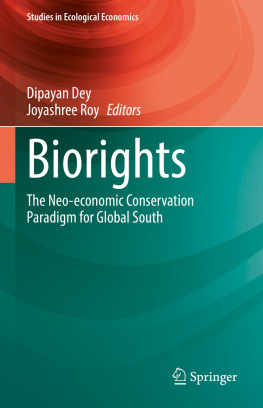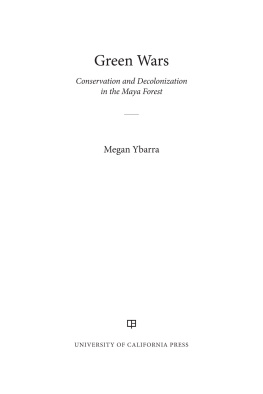Why Conservation Is Failing and How It Can Regain Ground
Why Conservation Is Failing and How It Can Regain Ground
ERIC T. FREYFOGLE

Copyright 2006 by Eric T. Freyfogle.
All rights reserved.
This book may not be reproduced, in whole or in part, including illustrations, in any form (beyond that copying permitted by Sections 107 and 108 of the U.S. Copyright Law and except by reviewers for the public press), without written permission from the publishers.
Set in type by SPI Publisher Services.
Printed in the United States of America.
Library of Congress Cataloging-in-Publication Data
Freyfogle, Eric T.
Why conservation is failing and how it can regain ground/Eric T. Freyfogle.
p. cm.
Includes bibliographical references.
ISBN-13: 978-0-300-11040-1 (alk. paper)
ISBN-10: 0-300-11040-5
1. Conservation of natural resources. I. Title.
S928. F74 2006
33. 72c22
2005023411
A catalogue record for this book is available from the British Library.
The paper in this book meets the guidelines for permanence and durability of the Committee on Production Guidelines for Book Longevity of the Council on Library Resources.
10 9 8 7 6 5 4 3 2 1
For Donald Worster
What the student (and teacher!) now needs is a text which cuts at right angles to these arbitrary divisions of the land problem; a text which describes the common mechanism of soils, waters, plants and animals as one integral whole; a text which treats of farms, forests, ranges and parks not as different resources, but as different uses of a single resource, the properties of which are first described as a single system, and then traced in their various land-use manifestations.
Aldo Leopold, 1940
For, alas, the Ideal always has to grow in the Real, and to seek out its bed and board there, often in a very sorry way.
Thomas Carlyle, 1843
Introduction
Participants in todays clashes regarding land conservationusing land in its broadest ecological sense, to include not just soils but wildlife, water, ecological processes, and humanstend to approach the battlegrounds from two quite different directions. Those who promote conservation typically respond to some inner longing to respect natures processes. They care about living creatures, often passionately, and want natures beauties and life forms near at hand. On their side, critics of conservation are prone to approach the issue from a felt need to protect individual liberty. They value the free exercise of entrepreneurial energies and prefer government to remain at bay. What neither side seems to deem necessary, as they debate and spar, is to consider conservation as a serious body of cultural and political thought.
Conservation advocates largely view this task as unnecessary. For them, a love of nature and the urge to conserve it provide sufficient motive and guidance for their work. Persistent critics of conservation avoid the task because it is unhelpful to themand because, practically speaking, they can get away with it. It is easier to criticize conservations ill-considered fringe than it is to seek out and evaluate its intellectual core. Intellectual atrophy has been one result of this inattention. Fragmented and ineffective conservation has been another.
The conservation cause is under siege today in large part because the public has become confused about what it is trying to do and at what cost. As critics see it, land conservation is about protecting nature from people. It is driven by a wilderness ideal in which humans inevitably bring about degradation. Worse than that, according to critics, laws restricting development trample on private property rights, constrain liberty, and inhibit economic growth. Given these complaints which are plausible enough on the surfaceis it any wonder that conservation efforts have stalled?
A century ago, conservations main stem had a clear, publicly understood goal. It was to promote That practical work has now largely passed to organized commercial interests such as Monsanto, Con-Agra, and Weyerhauser Paper. When conservationists today talk about resource flows its usually about the harms caused by their production and about such resource uses as recreation and wildlife protection, not about food, heat, and shelter. Conservation, so it appears, is about optional amenities rather than bread-and-butter basics. Laws protecting air and drinking water address essential human needs. But what about measures that preserve wildlands, free-flowing rivers, and rare species? How do they help people? How do they align with the values and dreams of ordinary Americans?
The conservation cause, I believe, is stymied less because of its disciplined opponents than because it lacks good overall direction. And it lacks this because it isnt taking time to stand backfrom its work, from society, and from the sweep of historyto think deeply about the larger questions. It is failing to attend seriously to its intellectual and ethical foundations and to ensure that its work and rhetoric build upon them. It isnt considering how land conservation fits into Americas self-image as the land of opportunity and progress. If the conservation cause doesnt take its own ideas seriouslyand by many measures it doesnt why should anyone else? Good intentions, good values, even high energy are not enough in themselves.
When taken seriously, as a vital strand of political and cultural thought, conservation poses a forceful challenge to elements of modern culture accepted as fundamental. It questions not merely specific land-use practices but our entrenched ways of seeing and valuing nature. It challenges our excessive faith in science and the capitalist market along with our exaggerated emphasis on individual autonomy. By situating humans within a value-infused natural order, the cause overlaps with religious traditions that honor the Creation. By emphasizing connections among people and between people and land, it promotes a community-centered perspective of life that contrasts with social views exalting individualism. In its call for citizens to broaden their moral and aesthetic sensibilities, it fits within Americas long heritage of progressive social reform.
Conservations intellectual core and intellectual leaders draw little attention save in the pages of academic journals. The public scarcely hears of them or from them. Among the thoughtful leaders are our environmental historians, who have been quietly telling us for years that land degradation is caused less by material factorssuch as population, technology, and fossil fuel usethan by our outdated cultural values and assumptions, particularly our ingrained tendency to treat nature as a warehouse of market commodities. To succeed, conservation has to confront these cultural flaws and do so in ways that are orchestrated and deliberate, not haphazard and indirect.
These groups protect valuable land parcels; their efforts, by and large, are useful. But piecemeal conservation work can come at high cost when it is not thoughtfully situated in a broader, grounded vision of people living harmoniously in an interconnected land. It can cause problems when it is not part of a well-considered challenge to business as usual in America.
Out in the field, tract-by-tract work competes for dollars and support with other conservation efforts. When its practitioners focus only on specific parcels, not on larger landscapes, they inevitably weaken conservations emphasis on ecological interdependence. Unless particularly careful in word and deed, they can also muddle the movements cultural criticisms, especially of free market capitalism and of our excessive individualism. We might consider, as a leading example of this conflict, the challenge of promoting conservation on privately owned lands. When one element of the conservation cause pays landowners to conserve (by buying easements or development rights or by endorsing government payment programs), how can another element contend that good land use ought to be a minimum obligation of citizen-owners, enforceable by legal sticks rather than financial carrots?












